You can test precious metals using seven key methods: visual inspection for hallmarks, magnetic testing to screen base metals, acid testing with touchstones for purity assessment, X-ray fluorescence (XRF) analysis for precise elemental composition, specific gravity measurements comparing density ratios, electronic resistivity testing, and fire assay laboratory analysis for ultimate accuracy. Each method offers different levels of precision and cost, from basic magnetic screening to professional laboratory services costing around £80. Master these techniques to make informed appraisal decisions and avoid costly authentication mistakes.
Visual Inspection and Hallmark Identification
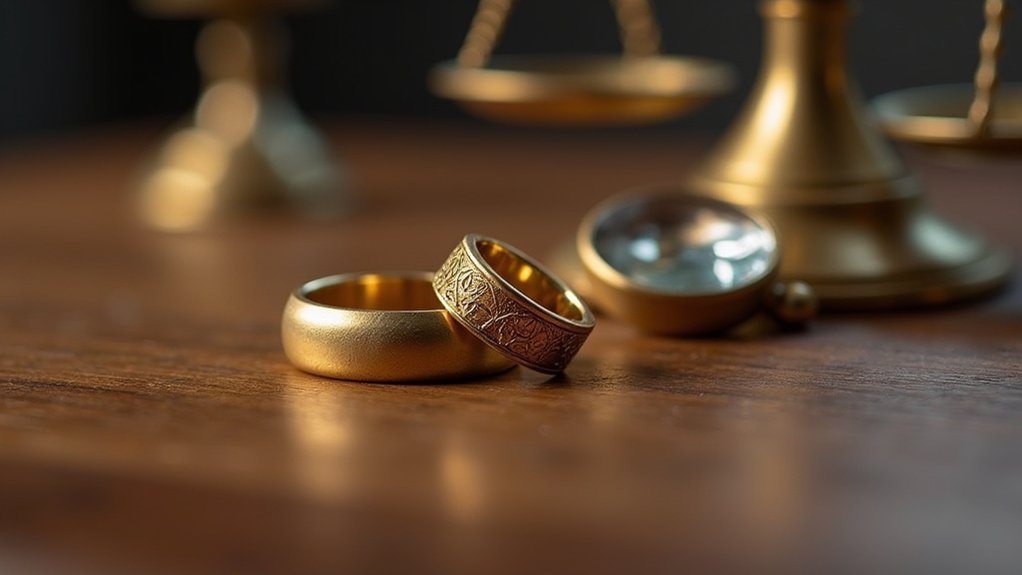
When you’re examining precious metals, the first step involves conducting a thorough visual inspection and identifying any hallmarks present on the item.
The foundation of precious metal authentication begins with careful visual examination and systematic identification of any existing hallmarks on the piece.
Look for visible hallmarks, as these are legal requirements in the UK that provide essential information about purity and authenticity. Use a jewellers loupe to examine small or intricate marks clearly, including the maker’s mark, assay office mark, and date letter.
Familiarize yourself with hallmark charts to properly interpret these stamps. However, be cautious of counterfeit items with forged hallmarks—always verify marks against reputable sources.
Consider the item’s overall characteristics like color, weight, and reflectivity, as these provide additional context during hallmark identification and help confirm the metal’s authenticity.
Magnetic Testing for Metal Authentication
One of the simplest and most accessible testing methods involves using a magnet to quickly screen precious metals from base alternatives.
Magnetic testing helps you identify authentic precious metals since gold and silver are non-magnetic, while many base metals attract magnets. However, you can’t rely solely on non-magnetic properties for authenticity confirmation, as copper and other non-gold metals also resist magnetic attraction.
You’ll find this method perfect for initial screening of jewelry, coins, or bullion. It’s cost-effective and completely non-destructive, making it ideal for quick assessments.
Remember that platinum sometimes exhibits magnetic properties, which complicates identification. While magnetic testing effectively eliminates obvious fakes, you’ll need more definitive tests like acid or XRF analysis to confirm authenticity conclusively.
Acid Testing With Touchstone Method
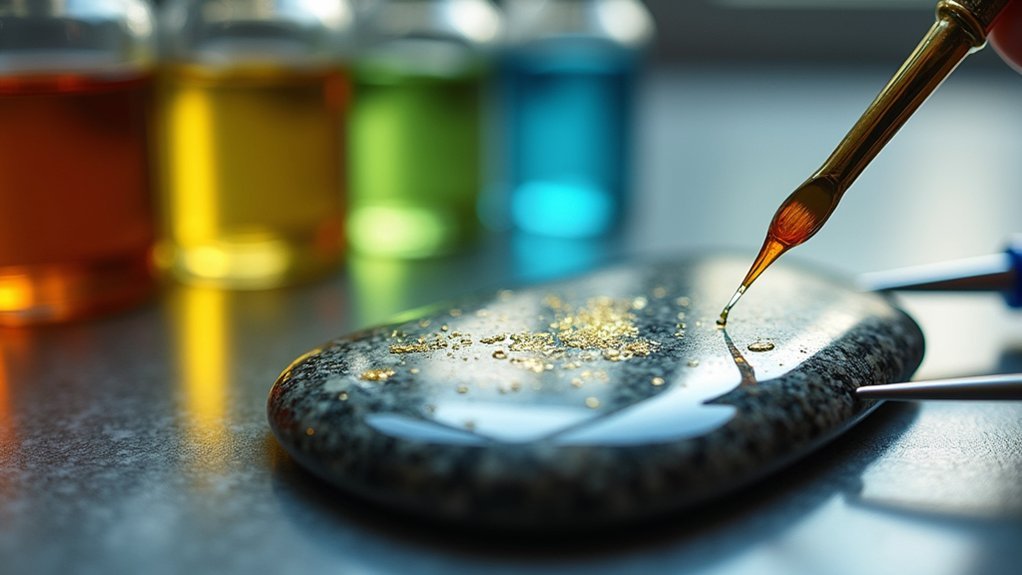
While magnetic testing offers a useful preliminary screening, acid testing with the touchstone method provides far more precise purity assessments for precious metals.
You’ll rub your metal sample against a specially designed stone, creating a mark for testing. Apply specific acid solutions corresponding to different karat values (10K, 14K, 18K, and 22K) to determine the purity of gold accurately.
Through visual observation of the reactions, you can assess whether you’re dealing with genuine metals or base metal imitations. If the scratch mark disappears, the metal’s purity is lower than the acid tested.
Remember essential safety precautions: wear gloves and goggles while working in well-ventilated areas. Cleaning the touchstone thoroughly after each use guarantees reliable results for future testing sessions.
X-Ray Fluorescence (XRF) Analysis
X-Ray Fluorescence (XRF) analysis represents a significant advancement in precious metal testing, delivering precise elemental composition results without damaging your valuable items. This non-destructive testing method uses x-rays to analyze metal types within seconds, providing percentage breakdowns for accurate identification of gold, silver, and platinum.
| Advantage | Consideration |
|---|---|
| Speed (seconds) | Surface must be filed |
| Non-destructive | Requires trained personnel |
| Wide metal range | Safety precautions needed |
| Precise percentages | Professional equipment cost |
| Professional grade | X-ray exposure risks |
You’ll find XRF widely used in assay offices due to its reliability and efficiency. However, proper surface preparation guarantees ideal readings, and safety precautions are essential since the process involves x-ray exposure requiring trained personnel for operation.
Specific Gravity Density Measurement
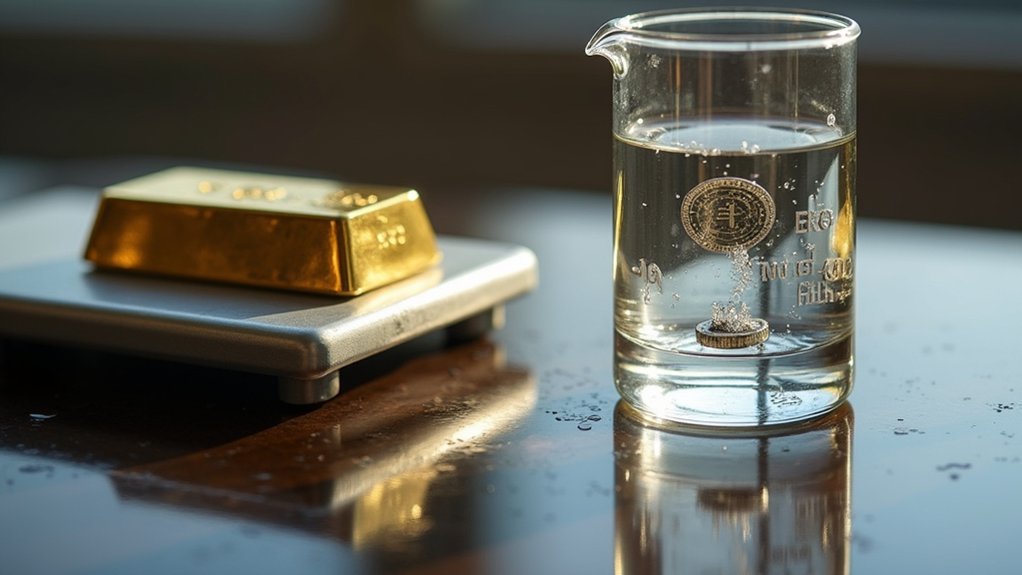
You’ll need specialized density testing equipment like the QuickTest Specific Gravity tester to measure how your precious metals displace water compared to their weight in air.
The SG calculation process involves weighing your sample in air, then in water, and dividing the air weight by the difference to determine if you’re dealing with real gold (SG 19.36) or silver (SG 10.53).
This method offers clear advantages as a non-destructive test, but you’ll face drawbacks like needing multiple readings for accuracy and potential measurement variations from handling.
Density Testing Equipment
When you need precise measurements without damaging your precious metals, density testing equipment offers a reliable solution through specific gravity analysis.
The QuickTest Specific Gravity tester works perfectly for smaller valuable items, weighing them in both air and water to deliver immediate density readings. For larger pieces, you’ll want a Densimeter that provides computerized calculations and detailed authenticity analysis.
These non-destructive testing methods allow you to verify precious metals without risking damage to rare coins or gemstones. By measuring density ratios, you can differentiate between gold’s specific gravity of 19.36 and silver’s 10.53.
This equipment eliminates guesswork, giving you confidence when evaluating the composition and authenticity of your valuable items through reliable, scientific testing methods.
SG Calculation Process
Understanding the specific gravity calculation process enables you to determine precious metal authenticity with scientific precision.
You’ll use the formula SG = weight in air / (weight in air – weight in water) to obtain accurate results. First, weigh your sample in air, then submerge it completely in water for the second measurement. A QuickTest Specific Gravity tester simplifies this process for smaller items.
Gold’s SG of 19.36 differs markedly from silver’s 10.53 and platinum’s 21.40, enabling clear differentiation between precious metals. This non-destructive method protects valuable items during testing.
You’ll need precise measurements for reliable SG calculation results. These appraisal tips help authenticate metals without damaging rare coins or gemstones.
Testing Advantages Drawbacks
While specific gravity testing offers exceptional accuracy for precious metal identification, it presents both significant benefits and notable limitations you should consider.
| Advantages | Drawbacks |
|---|---|
| Non-destructive method preserves valuable items | Time-consuming process unsuitable for busy retail |
| Reliable results for gold authenticity verification | Requires multiple readings and careful handling |
| Perfect for rare coins and gemstone appraisal | Limited to smaller items (three pound coins max) |
| Automated calculations with quality densimeters | Demands extensive knowledge of metal densities |
This testing method excels when you’re evaluating precious metals that can’t withstand damage. You’ll achieve dependable authenticity confirmation through density comparison, making it ideal for high-value appraisal work. However, the meticulous nature means you’ll need patience and expertise to execute proper specific gravity measurements effectively.
Electronic Resistivity Testing
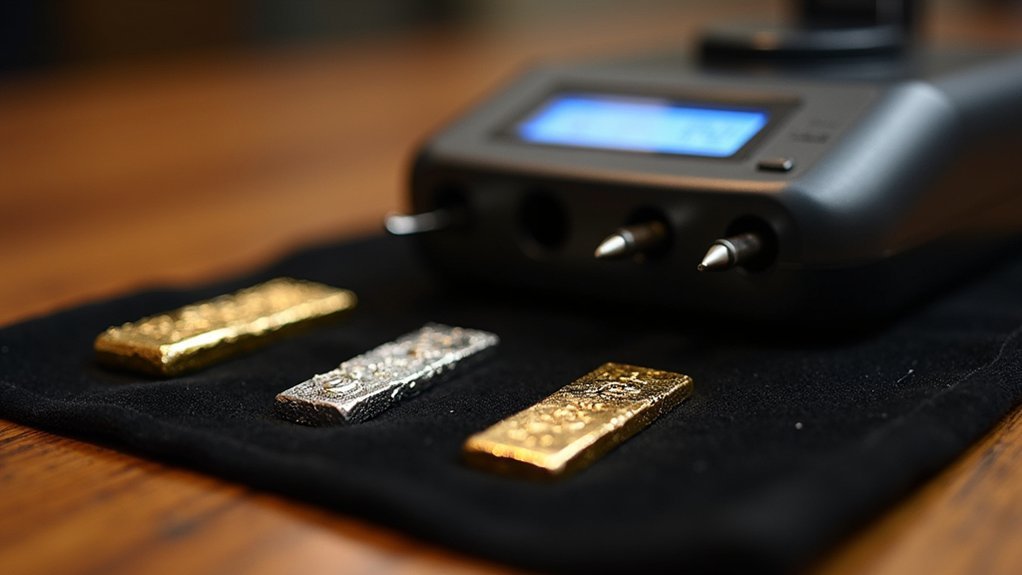
Electronic resistivity testing offers a non-destructive method for identifying precious metals by measuring their electrical resistance properties.
You’ll use specialized testing kits that apply probes for small items or bridge attachments for larger pieces to obtain accurate readings. This technique helps you identify and distinguish between similar-looking metals like electronic gold and copper by penetrating surfaces up to 2mm deep.
You must guarantee items reach room temperature before testing for best results.
While this method provides quick assessments of various metal types, it’s not standalone proof of authenticity. You’ll need solid knowledge of specific metals you’re testing, as similar compositions can produce confusing results.
The measure of success depends on understanding resistivity variations between different precious metal alloys.
Fire Assay and Laboratory Analysis
Fire assay stands as the gold standard for precious metal testing, offering unmatched accuracy when you need definitive results beyond what electronic methods can provide.
This traditional method determines gold content by melting your sample and separating precious metals from impurities using lead foil. Professional laboratories handle the specialized equipment and skilled procedures required.
You’ll get precise purity calculations as technicians weigh samples before and after melting. However, fire assay costs approximately £80 per test, though fees may be waived during metal sales.
For non-destructive alternatives, laboratory analysis techniques like Inductively Coupled Plasma and X-ray fluorescence provide detailed metal composition results without damaging your items.
These methods offer thorough precious metals analysis while preserving your valuables intact.
Frequently Asked Questions
What Is the Best Way to Test Precious Metals?
You’ll get the most reliable results by combining multiple methods. Start with hallmark analysis, then use acid testing for surface verification, and follow up with XRF testing for thorough composition analysis.
What Is the Best Method to Test for Metals?
You’ll find XRF analysis offers the best overall method for testing metals since it’s non-destructive, provides precise composition percentages, and delivers quick results without damaging your valuable samples.
How to Tell if Precious Metals Are Real?
You’ll verify precious metals by checking hallmarks with a loupe, conducting magnetic tests, performing acid tests on filed areas, weighing items for density, and comparing markings against official hallmark charts.
How Can I Test My Jewelry Metal at Home?
You can test your jewelry’s metal at home using a magnet to check if it’s magnetic, examining hallmarks with a magnifying glass, or performing a simple scratch test.
In Summary
You’ve now learned seven reliable methods to test precious metals, from basic visual inspection to sophisticated laboratory analysis. Don’t rely on just one technique—combine multiple testing methods for accurate results. Start with simple magnetic and visual tests, then move to acid testing or electronic methods for confirmation. When dealing with high-value items, you’ll want professional XRF analysis or fire assay to guarantee precise composition and avoid costly mistakes.

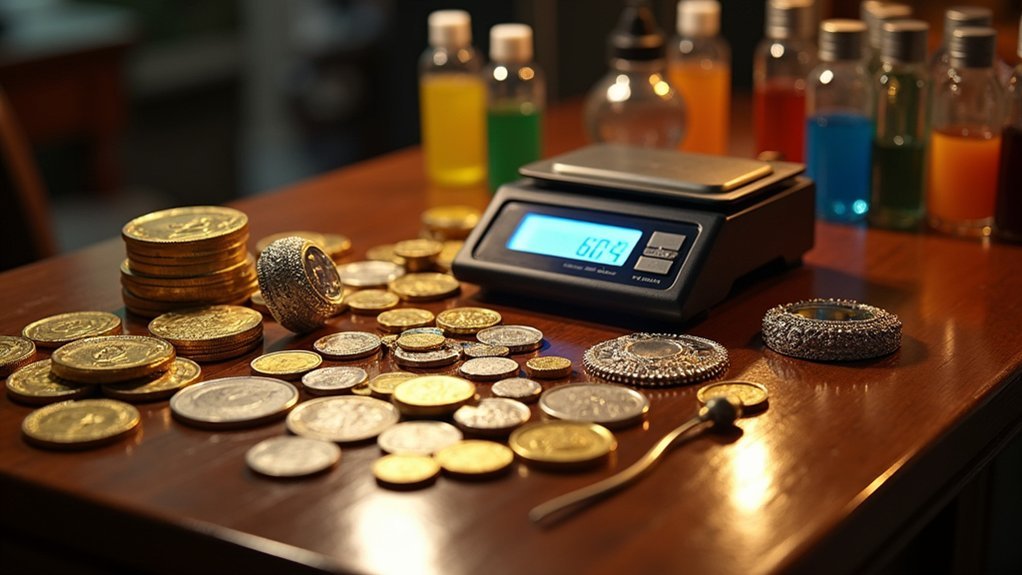



Leave a Reply